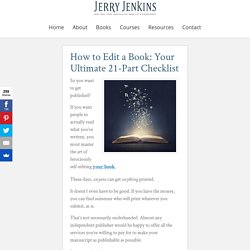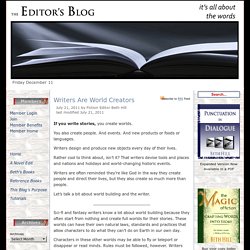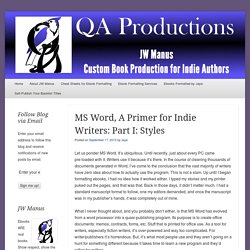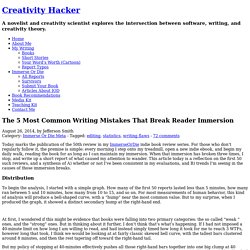

How to Edit a Book: The Ultimate Free 21-Part Checklist. So you want to get published?

If you want people to actually read what you’ve written, you must master the art of ferociously self-editing your book. These days, anyone can get anything printed. It doesn’t even have to be good. Writing About Fighting » Inkpunks. One of the most helpful writing panels I’ve ever been to was at VCon in 2008, called Writing About Fighting.

I learned so much from the panelists, got inspired to finally start taking martial arts and have had since had the honour of joining this annual panel at VCon. I’ve asked two of the panelists who had the most impact on me to share their wisdom in this Inkpunks blog post. If you’ve ever worried about getting a fight scene right, read on to gain insights into how it should and shouldn’t be done. Now, just to be sure you know why you should listen to these artists please allow me to introduce you to Devon Boorman and T. The 3 words that are guaranteed to make your writing better. Want to know the secret to all good storytelling — and even all good writing?

Watch the above video by Tony Zhou, the creator and director of the YouTube film essay series Every Frame a Painting. In it, Zhou marvels at the Orson Welles film F for Fake. It's ostensibly a documentary about an art forger, but Welles (best known as the director of Citizen Kane) eventually builds out the film into more of a freeform essay on the nature of trickery, the impossibility of objective truth, and art's role as a sort of truth built atop a foundation of falsehoods. As Zhou points out, at the film's high point, Welles is cutting between six different stories. How I Write A Script. Tips for World Building in Fiction. July 21, 2011 by Fiction Editor Beth Hill last modified July 21, 2011 If you write stories, you create worlds.

You also create people. And events. And new products or foods or languages. 6 Writing Techniques I Learned at Storymasters. MS Word, A Primer for Indie Writers: Part I: Styles. Let us ponder MS Word.

It’s ubiquitous. Until recently, just about every PC came pre-loaded with it. Writers use it because it’s there. In the course of cleaning thousands of documents generated in Word, I’ve come to the conclusion that the vast majority of writers have zero idea about how to actually use the program. Speculative fiction world-building techniques you need to know. 43 Words You Should Cut From Your Writing Immediately. When you’re revising any piece of writing — a novel, a news article, a blog post, marketing copy, etc. — there are certain words you should delete to make the text stronger and cut your word count.

When I’m writing a novel, one of my last drafts focuses on cutting these useless words. Removing them helps speed up the pacing of both action and dialogue, and makes your work more polished and professional. While this might not be the ultimate list of all words you should remove, these are the ones I look for when I’m doing revisions, so I thought other writers out there would find this helpful! Also, my examples below might be exaggerated, but I hope they get the points across. Are You Waving The Novice Writer Flag? by Rayne Hall. Rayne Hall returns with advice on how to avoid the tell tale signs of a newbie writer.

Happy to have you back, Rayne! Editors can tell if a writer is a novice or a veteran from the words appearing on the first page. New writers unconsciously share the same word set. The Big Reason Why Agents and Editors Often Stop Reading. By Russell Honeywell | via Flickr Note from Jane: Today’s post is an excerpt from Paula Munier’s Writing with Quiet Hands, recently released from Writer’s Digest Books.

As a reader, a writer, and an agent, I read thousands of stories a year—or at least the opening pages of thousands of stories. And, all other things being equal, the reason I most often stop reading is a lack of narrative thrust. Narrative thrust is the taut building of story, beat by beat, scene by scene, chapter by chapter, using the complexities of plot and character to propel the story forward in a dramatic arc that peaks at the climax. 7 Rules for Writing Dialogue. Dialogue can serve a number of purposes in fiction including developing character, building suspense and advancing plot.

If written well, it engages readers and increase their identification with characters. Here are 7 rules for writing dialogue: The 5 Most Common Writing Mistakes That Break Reader Immersion. Today marks the publication of the 50th review in my ImmerseOrDie indie book review series.

For those who don’t regularly follow it, the premise is simple: every morning I step onto my treadmill, open a new indie ebook, and begin my daily walk, reading the book for as long as I can maintain my immersion. When that immersion has broken three times, I stop, and write up a short report of what caused my attention to wander.
This article today is a reflection on the first 50 such reviews, and a synthesis of A) whether or not I’ve been consistent in my evaluations, and B) trends I’m seeing in the causes of those immersion breaks. Distribution. 10 Scenes for the Mentor Character in your Novel. Don’t Jump to Conclusions: The Perils of “Underwriting” This month our editors are tackling Fatal Flaw #9—Underwriting. Too often necessary information is left out of a scene, leaving readers scratching their heads. This may pertain to narrative, dialog, setting—every and any component found in fiction. Dumb Little Writing Tricks That Work.
Chuck Jones's 9 rules for writing Wild E. Coyote and the Road Runner cartoons. You’d have thought that there were no rules for cartoons which contain such erratic goings-on as animals surviving cliff falls and intricate dynamite traps, but apparently there is. Looney Tunes cartoonist Chuck Jones seemingly worked by a set of nine guidelines when writing scenarios for Wile.E.Coyote and Road Runner cartoons. The poor Coyote never had any luck in catching his dinner and was foiled in a number of ways but, as the above graphic shows, there were only certain ways he could be defeated. Chuck Jones's Road Runner rules in full: 1. The Road Runner cannot harm the Coyote except by going ‘Beep-Beep!’ Delilah S. Dawson: 25 Blood-Spattered Tips For Writing Violence. Delilah is one of those people to whom I will toss the keys to this blog, no matter the purpose.
I do worry that one day I’ll come home to find that every blog page is just ALL WORK AND NO PLAY MAKES DELILAH A BITEY WOMBAT but so far that hasn’t happened. So, once again, I hand over the keys. How to Write a Book in Three Days: Lessons from Michael Moorcock. This article is the first part of a series about one of my favorite writers, Michael Moorcock, which will culminate in an interview with the man himself. In the early days of Michael Moorcock's 50-plus-years career, when he was living paycheck-to-paycheck, he wrote a whole slew of action-adventure sword-and-sorcery novels very, very quickly, including his most famous books about the tortured anti-hero Elric.
In 1992, he published a collection of interviews conducted by Colin Greenland called Michael Moorcock: Death is No Obstacle, in which he discusses his writing method. In the first chapter, "Six Days to Save the World", he says those early novels were written in about "three to ten days" each, and outlines exactly how one accomplishes such fast writing. This is not the best way to write every novel, or even most novels. Moorcock used it specifically to write sword-and-sorcery action-adventure, but I think it could be applied more-or-less to any kind of potboiler.
20 Fiction Writing Renovations in Super-Short, Simplified Format By Randy Susan Meyers During my (self-guided, self-nagged) courses in my ‘Homemade MFA’ I did many things: I read stacks of books, I read multiple favorite novels with an analytical eye, I participated in multiple writer’s groups and revised, revised, and then revised some more. And, I wrote ‘papers’ for myself, in an attempt to distill down all the fantastic advice I’d gleaned from those book stacks. What I couldn’t learn from the books was ‘voice,’ ‘passion’ or ‘perseverance’ — that required mining my own soul and level of commitment; what I could learn was those all important, and too often ignored, techniques that make one’s prose more sophisticated.
Should You Be Using a Pen Name? by Helen Sedwick. These ‘Color Thesaurus’ Charts Let You Correctly Name Any Color Imaginable. Save the Cat!® The 5 Most Common Writing Mistakes That Break Reader Immersion. The Writing Café. Be Accountable to the Muse: A Creative Approach to the Writer’s Production Plan by Joanna Penn. Writing Fiction: 3 Ways to Build a Stronger Story. How to write a story. How to Write a Novel - Novel Writing Tips. How Long Should Your Novel Be? The Definitive Post! — Kevin T. Johns. 17 Ways To Make your Novel More Memorable. Cheat Sheets for Writing Body Language. Seven Extremely Good Reasons to Write the Ending First.
Add Color and Impact. 10 Tips on Writing from David Ogilvy. How to Write with Style: Kurt Vonnegut’s 8 Keys to the Power of the Written Word. Clean Up Your Narration: Four Tips For Fiction Writers. The Biggest Mistake New Writers Make and 5 Ways to Avoid It. 7 Keys To Write the Perfect First Line of a Novel.